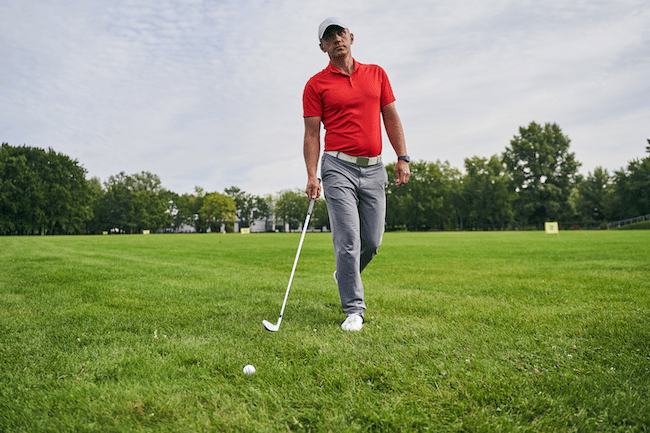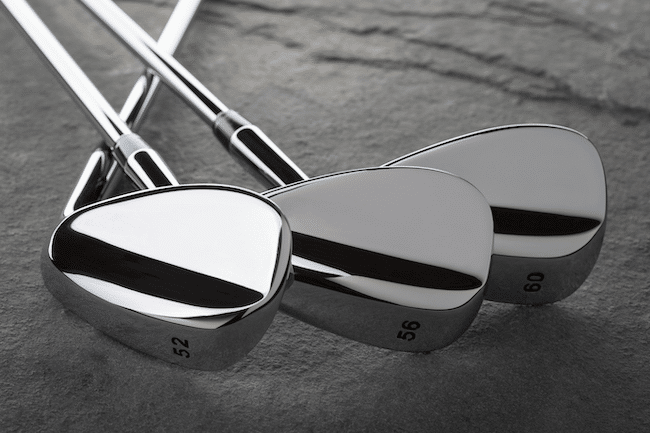Let’s face it. Bad approach shots are score-killers. You need to get the distance just right with your wedges. That’s where a golf wedge distance chart will help you identify what club you should use.
You can also use it to easily compare your distances with other players. This knowledge is essential in helping you assess whether you are on the right track. At the same time, it can motivate you to improve your skills.
If you don’t know your wedge distances, you might miss out on knocking a few easy strokes off your rounds.
Read on to learn the average distances of most wedges across a diverse range of players, including an analysis of which wedges you should definitely have in your bag.
Average Golf Wedge Distance Charts & Ranges
This chart contains the average distance range within which male and female players use each type of wedge. For comparison, we also included the average PGA and LPGA professionals averages.
Note that these are just general ranges compiled through our research, and individual skill levels will determine where each player lies within these ranges. You can see more in the charts below.
This information should help you get a feel of the exact capabilities of each wedge and where you can use it. Of course, you can also hit your wedge in varied ways to achieve different results.
| Wedge | Male Player | PGA professionals | Female players | LPGA Professionals |
| Pitching Wedge | 70-135 yards | Up to 146 yards | 50-115 yards | Up to 128 yards |
| Gap Wedge | 60-120 yards | Up to 135 yards | 45-95 yards | Up to 117 yards |
| Sand wedge | 50-110 yards | Up to 124 yards | 40-85 yards | Up to 108 yards |
| Lob Wedge | 40-113 yards | Up to 113 yards | 35-70 yards | Up to 97 yards |
Individual Wedge Club Distance Charts

We compiled the average distances for various skill leveled players using each type of wedge. Note that these averages are calculated only from well-hit shots.
Here are the stats:
48 Degree Pitching Wedge Distance Chart – Male Golfers
| Skill Level | Distance in Yards |
| Beginner Players | 70 |
| Average level Players | 100 |
| Good players | 110 |
| Excellent Players | 135 |
| PGA Professionals | 146 |
48 Degree Pitching Wedge Distance Chart – Female Golfers
| Skill Level | Distance in Yards |
| Beginner Players | 50 |
| Average level Players | 60 |
| Good players | 80 |
| Excellent Players | 115 |
| LPGA Professionals | 128 |
52 Degree Gap Wedge Distance Chart – Male Golfers
| Skill Level | Distance in Yards |
| Beginner Players | 60 |
| Average level Players | 90 |
| Good players | 100 |
| Excellent Players | 120 |
| PGA Professionals | 135 |
52 Degree Gap Wedge Distance Chart – Female Golfers
| Skill Level | Distance in Yards |
| Beginner Players | 45 |
| Average level Players | 55 |
| Good players | 70 |
| Excellent Players | 95 |
| LPGA Professionals | 117 |
56 Degree Sand Wedge Distance Chart – Male Golfers
| Skill Level | Distance in Yards |
| Beginner Players | 50 |
| Average level Players | 80 |
| Good players | 95 |
| Excellent Players | 110 |
| PGA Professionals | 124 |
56 Degree Sand Wedge Distance Chart – Female Golfers
| Skill Level | Distance in Yards |
| Beginner Players | 40 |
| Average level Players | 50 |
| Good players | 60 |
| Excellent Players | 85 |
| LPGA Professionals | 108 |
60 Degree Lob Wedge Distance Chart – Male Golfers
| Skill Level | Distance in Yards |
| Beginner Players | 40 |
| Average level Players | 60 |
| Good players | 80 |
| Excellent Players | 100 |
| PGA Professionals | 113 |
60 Degree Lob Wedge Distance Chart – Female Golfers
| Skill Level | Distance in Yards |
| Beginner Players | 35 |
| Average level Players | 45 |
| Good players | 50 |
| Excellent Players | 70 |
| LPGA Professionals | 97 |
Types of Golf Wedges

In general, there are four types of wedges. These 4 are; a Pitching Wedge(PW), Gap Wedge (GW), Sand Wedge (SW), and a Lob Wedge (LW). Now the main difference between all these is that they all come with a specific loft degree to allow each to perform specific unique tasks.
- Pitching Wedge- Most players will probably be familiar with a pitching wedge. This is because they tend to be included in sets of clubs. Because of its low loft, it is an ideal choice for high and short-trajectory shots, usually from the fairway. It can also be used effectively for low and long-trajectory chipping. A standard pitching wedge is going to have a loft of anywhere from 41 to 46 degrees.
- Gap Wedge- As the name suggests, the gap wedge fills the loft degree space between a pitching wedge and a sand wedge. You will hear some people call this an approach wedge. This is because it is usually used for approach shots. Players will go for this if they are looking for something that will hit higher than a pitching wedge but lower than a sand wedge. A standard Gap Wedge will have a loft of anywhere from 50 to 54 degrees.
- Sand Wedge- The sand wedge is designed specifically to help players get out of bunkers. You can also use it for various chipping shots as it has the widest sole. In addition, you can also use it on long greens if you don’t trust your putt. Standard sand wedges have loft degrees in the 54-56 degree range.
- Lob Wedge- a lob wedge is generally the club with the most loft in the bag. They are designed this way to allow players to achieve high-flight shots that land without rolling too much. This can be especially ideal if you want to overcome a large obstacle. A standard lob wedge is going to have a 60 degree loft. However, they also range anywhere from 58 to 64 degrees, with some even having lofts as high as 72 degrees. Very skilled players mostly use this type of wedge.
Related: Lob Wedge vs. Sand Wedge
Which Wedges Should I Have in My Bag?
Now that you know the different types of wedges, you are probably wondering which ones you should carry on the course.
Ultimately, each type of wedge is going to have its unique strengths. So you want to have a bit of diversity to tackle every kind of scenario. An example of a popular choice of wedges amongst players (including beginners) is a pitching wedge, gap wedge, and sand wedge. This combination of clubs has just enough loft degree difference to give you a diverse range of shot options for different scenarios. However, many golfers just use one wedge in their bag.
There are also no limits to the number of wedges you can have in your bag. For instance, you can add a lob wedge to the above selection just in case you need something to get you through a huge obstacle and land without rolling. Just ensure you aren’t sacrificing another useful club for one you may not need.
Ultimately, you should choose what works for you. For example, Cameron Smith often carries 3 lob wedges. To find the perfect combination, you might want to invest some time in practicing with each type of wedge and learning their (and your) strengths.
How To Measure Golf Wedge Distances

In order to know where you stand compared to the average wedge distances of other players, you may need to measure your own golf club distances.
Luckily, there are various ways you can measure the distances of each of your wedges. The easiest method is to go to any indoor or driving range trackman bay and let the platform do the calculations.
Alternatively, you can also use devices such as rangefinders or GPS to track your distances.
Simply find an area within the course where you can easily see the ball’s flight and easily retrieve the balls. The next step is to take as many shots as possible with each club and then calculate the average for your average wedge distances. The more shots you take, the more accurate your results will be.
It is important to remember that when it comes to wedges, it’s not necessarily about how far you can hit with each club. Rather, it’s about finding your range with each club and working on hitting the shots as precisely as possible each time.
Factors That Can Impact Wedge Club Distances
Now, it is important to note that a diverse range of factors can impact the distance of wedge shots.
You probably already know that the skill level and sex of various players will play a huge part in the exact distance achievable using a wedge club.
Other factors include:
- Weather
- Lie conditions
- Mishits
These will also impact the distance of your wedge shots.
But the most important factor is swing speed. A beginner golfer with huge swing speeds can rival distances of much more experienced golfers, providing they make good contact with the ball.
More experienced players will also concentrate on shot shaping rather than distance alone, and changing up the swing affects the time in the air and the roll (hopefully) on the green.
Wrapping Up
While it helps to know roughly far you can hit each type of wedge using a golf wedge distance chart, don’t forget about the fundamentals of your swing to get the most out of every club in your bag. If you find yourself trying to swing at max speed with a wedge anyway, you’re likely better off using an iron for the shot you’re trying to take. You must get out there and practice with your wedges to find exactly how far you hit them.
Chris's love for golf is only rivaled by his wanderlust. A globetrotter at heart, He’s played courses throughout Europe and Asia and at home in NSW, Australia. With a writing style as smooth as his golf swing, he’ll help you find the right gear to match your skill level and style. You can connect with Chris on LinkedIn.






